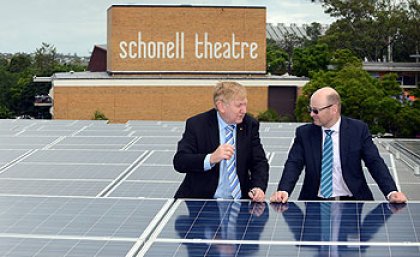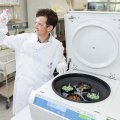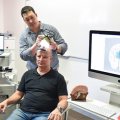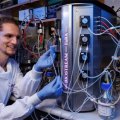
The University of Queensland will assist RATCH-Australia Corporation Limited (RAC) assess the viability of converting the coal-fired Collinsville Power Station owned by RAC to a hybrid solar thermal / gas power station.
RAC will partner with UQ in the $5.6 million feasibility study, supported by $2.5 million from the Australian Renewable Energy Agency’s (ARENA) Emerging Renewables Program.
The federal Minister for Resources and Energy, Martin Ferguson, announced ARENA’s funding for the Collinsville research during a visit to UQ today and said the work would advance knowledge on hybrid power plants and accelerate the deployment of concentrating solar thermal power generation.
In recent years UQ had made a significant push into various types of solar energy research said Vice-Chancellor Professor Peter Høj.
“This University has a fundamental, core focus on sustainability in its operations and it supports a number of research projects in this area,” Professor Høj said.
“We are delighted to partner with RATCH-Australia and ARENA in multi-pronged research that we expect to significantly support the transition to renewable energy supplies.”
Professor Høj said solar research at the University had gained real momentum in recent years, and UQ was now among Australia’s leading universities in this area.
“The University now has an expansive portfolio of solar research programs spanning basic science, engineering, plant deployment and economics.”
“For example, in 2011 we built and commissioned Australia’s largest rooftop PV array, recently announced our participation in the $87 million CSIRO-led Australian Solar Thermal Research Initiative and are lead research partners on the $450 million AGL Solar Flagships project.”
“We are delighted to add the Collinsville project to this growing list of initiatives.”
Lead researcher Professor Paul Meredith from UQ’s Global Change Institute said the research would provide valuable insights into whether existing generation assets could be converted to produce affordable and cleaner power using Australia’s abundant solar resource.
“The project will generate critical information relating to the overall technical, economic and environmental viability of coal fired plant conversion and share this information broadly amongst the community,” Professor Meredith said.
The 180MW Collinsville power station was built in 1968, and refurbished in 1998. Under the new plans, it will become a 30MW gas / solar thermal plant.
RAC owns the Collinsville plant, among a total 815MW portfolio of Australian power generating assets, including three wind farms. RAC is owned by a large Thai power generation company, Ratchaburi Electricity Generating Holding PCL, and Transfield Services Ltd.
On the Collinsville study, RAC will partner with UQ to better understand factors impacting on the feasibility, including yield and dispatch forecasting, cleaning requirements, power system stability and transient effects, energy economics and fossil fuel boiler integration.
As part of the overall project RAC will examine the feasibility of using Novatec’s Supernova Linear Fresnel Solar Thermal technology to generate steam to be used in a steam turbine at Collinsville.
The feasibility study is expected to be complete in early 2015.
ARENA was established on 1 July 2012 as part of the Federal Government’s Clean Energy Future plan.
UQ is home to Australia’s largest rooftop solar photovoltaic array. The 1.22MW system was installed in 2011 and provides about five per cent of the peak power demand at the St Lucia campus in Brisbane.
More information on UQ’s solar facilities and research is here.
Media: Anna Bednarek, UQ Communications, 0478 487 211
Photos will be available immediately after the announcement. Please contact Anna Bednarek for high-resolution images.
.jpg)











